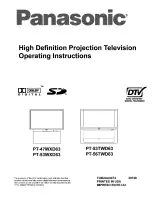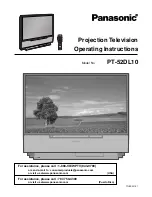
INSTALLATION & SETUP
To summarize, curved screens are better suited for brightly lit rooms where the audience
is situated within the viewing cone. Flat screens are best suited when a wide viewing
angle is required and ambient room lighting (near the screen) is low.
Note: Screen Gain is defined in Appendix
A,
Glossary.
Rear Screen Installations
There are two basic types of rear screens: diffused and optical. A diffused screen has a
surface, which spreads the light striking it. Purely diffused screens have a gain of less
than 1. The main advantage of the diffused screen is its wide viewing angle, similar to
that of a flat screen for front screen projection.
Optical screens take light from the projector and redirect it to increase the light intensity
at the front of the screen. This reduces it in other areas. A viewing cone, similar to that of
a curved front screen installation, is created.
To summarize, optical screens are better suited for brightly lit rooms where the audience
is situated within the viewing cone. Diffused screens are best suited when a wide viewing
angle is required but there is low ambient room lighting.
Screen Size and Throw Distance >
Screen size and throw distance are interrelated. See Appendices F and G. As screen size
increases, the distance between the projector and the screen also increases. During
projection room design, make sure that the room can accommodate the required position
of the projector for the screen size you need.
Screen Size
Screen sizes vary according to model and lens type. See Appendices F and G.
Choose a screen size, which is appropriate for your application. If the projector will be
used to display text information it is important that the image size allows the audience to
clearly resolve all text. The eye usually sees a letter clearly if eye-to-text distance is less
than 150 times the height of the letter. Small text, located too far from the eye, may not
be legible at a distance even though it is projected sharply and clearly on the screen.
To fill a screen with an image, the aspect ratio of the screen must be equal to the aspect
ratio of the image. The aspect ratio of an image is the ratio of its width to its height.
Standard video from a VCR
has a 4:3 or 1.33:1 aspect ratio. For example, to display a
VCR
output with a 4:3 aspect ratio onto a 10-foot (3m)
high screen, the width of the
screen must be at least 13.3 feet (4m).
Note: Screen size is often specked as diagonal size. Screens specked by diagonal size
have aspect ratios of 4:3. Screens with other aspect ratios are not typically specked by
diagonal size.
2-4
Содержание Model 9
Страница 1: ......
Страница 44: ...INSTALLATION SETUP Figure 2 29 ACON Installation Examples 2 38...
Страница 104: ...Physical Dimensions 5 5...
Страница 105: ...5 6...
Страница 113: ...A p p e n d i x B B 1...
Страница 114: ...B 2...
Страница 115: ...C 1...
Страница 116: ...C 2...
Страница 117: ...D 1...
Страница 118: ...D 2...
Страница 119: ...E 1...
Страница 120: ...F 1...
Страница 121: ...F 2...
Страница 122: ...F 3...
Страница 123: ...F 4...
Страница 124: ...F 5...
Страница 125: ...F 6...
Страница 126: ...F 7...
Страница 127: ...F 8...
Страница 128: ...F 9...
Страница 129: ...F 10...
Страница 130: ...G 1...
Страница 131: ...Index 1...
Страница 132: ...Index 2...











































